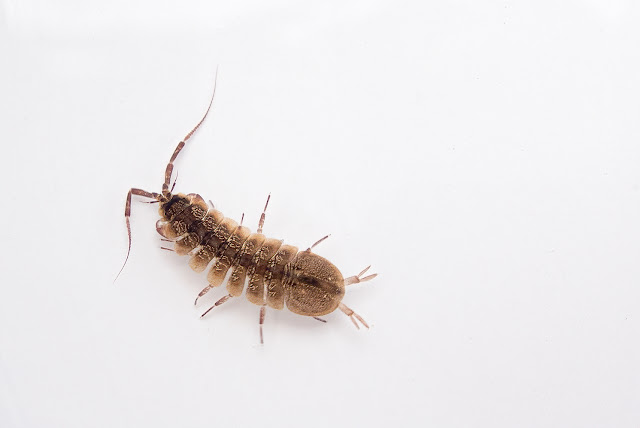Clean-Up Duty
 |
| Fresh-Water Isopod from the Homer Lake Wetland |
Monitoring my underwater camera from my iPhone, I saw a bizarre looking little creature making its way over the bottom of the pond, like a miniature tank over the terrain. I only caught a glimpse before it was out of sight but grabbed my net to see if I could get a better look. The photo above shows the larger of the two that came up along with a dozen or more fairy shrimp and one very small crayfish (more on the crayfish soon).
If you think about where you've seen something like this before, if you do any yard or garden work, you may very well be reminded of the little roll'em-up bugs (or "pill bugs" or "sow bugs" or "woodlice") that are easily found in moist soil and under rocks, etc... and for good reason because they are related. Both the pill bugs of your garden and this creature from the bottom of the wetland pond are isopods, which like the fairy shrimp we've already seen and the crayfish we'll soon be looking at, are crustaceans along with lobsters and crabs. Like the land-dwelling isopods you likely see around your yard or garden, these pond-dwelling isopods also feed on decaying materials, helping to keep the place clean!
About half of the world's 10,000 species of isopods live on land, making them the most successful land-dwelling crustaceans. Interestingly, the land-dwelling isopods still breath through gills and so are restricted to humid and damp environments, such as under logs. Of the remaining 5000 species of isopods, the majority live in the world's oceans, but about 500 species are found in freshwater. The one pictured above was probably about 3/4 of an inch long, but the largest species, which can be found in the deep sea, can be up to 20" long!
As for everything else living in the pond at the Homer Lake wetland (as opposed, for example, to Collins Pond at Homer Lake, which is a permanent body of water), one of the problems to be solved is how to survive the months the pond is completely dry, typically from late Summer through late Fall. Research detailed in the paper noted below concludes that isopods that live in temporal pools most likely retreat into the ground as the pool dries up and exist there in a dormant state until the water returns. This is in contrast to the fairy shrimp which survive the dry periods as the next generation still in their eggs.
For more on isopods, see any of the following resources, which have been helpful to me:
- https://www.researchgate.net/publication/344110098_Freshwater_Isopods_Crustacea_Isopoda_Asellidae_Inhabiting_Upland_Vernal_Pools_in_Maryland -- scroll down to "Dry Period Survival" for discussion of how they make it through the dry months
- https://www.inhs.illinois.edu/resources/inhsreports/sum-2000/isopods/ -- an informative article on land isopods by Susan Post of the Illinois Natural History Survey
- https://en.wikipedia.org/wiki/Isopoda



Comments
Post a Comment